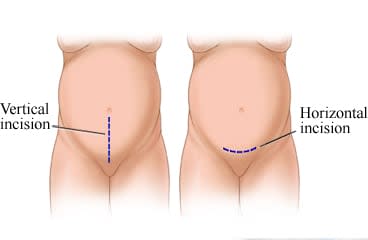Your Recovery

A cesarean section, or C-section, is surgery to deliver your baby through a cut that the doctor makes in your lower belly and uterus. The cut is called an incision.
You may have some pain in your lower belly and need pain medicine for 1 to 2 weeks. You can expect some vaginal bleeding for several weeks. You will probably need about 6 weeks to fully recover.
It's important to take it easy while the incision heals. Avoid heavy lifting, strenuous activities, and exercises that strain the belly muscles while you recover. Ask a family member or friend for help with chores at home.
This care sheet gives you a general idea about how long it will take for you to recover. But each person recovers at a different pace. Follow the steps below to get better as quickly as possible.
How can you care for yourself at home?
Taking care of your body
- Use pads instead of tampons for bleeding. After birth, you will have bloody vaginal discharge. You may also pass some blood clots that shouldn't be bigger than an egg. Over the next 6 weeks or so, your bleeding should decrease a little every day and slowly change to a pinkish and then whitish discharge.
- For cramps or mild pain, try an over-the-counter pain medicine, such as acetaminophen (Tylenol) or ibuprofen (Advil, Motrin). Read and follow all instructions on the label.
- If your doctor or midwife gave you a prescription medicine for pain, take it as prescribed.
- To ease pain around the vagina or from hemorrhoids:
- Put ice or a cold pack on the area for 10 to 20 minutes at a time. Put a thin cloth between the ice and your skin.
- Try sitting in a few inches of warm water (sitz bath) when you can or after bowel movements.
- Clean yourself with a gentle squeeze of warm water from a bottle instead of wiping with toilet paper.
- Use witch hazel or hemorrhoid pads (such as Tucks).
- Ease constipation by drinking plenty of fluids and eating high-fiber foods. Ask your doctor or midwife about over-the-counter stool softeners.
- Try using a cold compress for sore and swollen breasts. And wear a supportive bra that fits.
Activity
- Rest when you feel tired. Getting enough sleep will help you recover. Ask for help from family or friends when you need it.
- When you feel ready, try to get some exercise every day. For many people, walking is a good choice.
- Avoid lifting anything heavy or doing strenuous activities, such as bicycle riding, jogging, weightlifting, and aerobic exercise, for 6 weeks or until your doctor or midwife says it is okay.
- Do not do sit-ups or other exercises that strain the belly muscles for 6 weeks or until your doctor or midwife says it is okay.
- Hold a pillow over your incision when you cough or take deep breaths. This will support your belly and decrease your pain.
- Ask your doctor or midwife when you can drive again.
- You will probably need to take at least 6 weeks off work. It depends on the type of work you do and how you feel.
- Ask your doctor or midwife when it is okay to have sex.
- If you don't want to get pregnant, talk to your doctor or midwife about birth control options. You can get pregnant even before your period returns. You can also get pregnant while you are breastfeeding.
- Talk to your doctor or midwife if you want to get pregnant again. They can talk to you about when it is safe.
Incision care
- If you have strips of tape on the incision, leave the tape on until it falls off. If you have stitches, they will dissolve on their own and don't need to be removed.
- Wash the area daily with warm, soapy water, and pat it dry. Don't use hydrogen peroxide or alcohol, which can slow healing. You may cover the area with a gauze bandage if it oozes or rubs against clothing. Change the bandage every day. Keep the area clean and dry.
- You may shower as usual. Pat the incision dry when you are done.
Taking care of your emotional health
- It's normal to have some sadness, anxiety, and mood swings after delivery. You can always call the Maternal Mental Health Hotline at 1-833-TLC-MAMA (1-833-852-6262) for support. If these mood changes last more than a couple of weeks, talk to your doctor or midwife.
Follow-up care is a key part of your treatment and safety. Be sure to make and go to all appointments, and call your doctor if you are having problems. It's also a good idea to know your test results and keep a list of the medicines you take.
When should you call for help?
Share this information with your partner, family, or a friend. They can help you watch for warning signs.
Call 911 anytime you think you may need emergency care. For example, call if:
- You feel you cannot stop from hurting yourself, your baby, or someone else.
- You passed out (lost consciousness).
- You have chest pain, are short of breath, or cough up blood.
- You have a seizure.
- You have severe vaginal bleeding. You have soaked through one or more pads in an hour, and the bleeding is not slowing down.
Where to get help 24 hours a day, 7 days a week
If you or someone you know talks about suicide, self-harm, a mental health crisis, a substance use crisis, or any other kind of emotional distress, get help right away. You can:
- Call the Suicide and Crisis Lifeline at 988.
- Text HOME to 741741 to access the Crisis Text Line.
Consider saving these numbers in your phone.
Go to 988lifeline.org for more information or to chat online.
Contact your doctor or midwife now or seek immediate medical care if:
- You have loose stitches, or your incision comes open.
- You have signs of hemorrhage (too much bleeding), such as:
- Heavy vaginal bleeding. This means that you are soaking through one or more pads in an hour. Or you pass blood clots bigger than an egg.
- Feeling dizzy or lightheaded, or you feel like you may faint.
- Feeling so tired or weak that you cannot do your usual activities.
- A fast or irregular heartbeat.
- New or worse belly pain.
- You have symptoms of infection, such as:
- Increased pain, swelling, warmth, or redness.
- Red streaks leading from the incision.
- Pus draining from the incision.
- A fever.
- Frequent or painful urination or blood in your urine.
- Vaginal discharge that smells bad.
- New or worse belly pain.
- You have symptoms of a blood clot in your leg (called a deep vein thrombosis), such as:
- Pain in the calf, back of the knee, thigh, or groin.
- Swelling in the leg or groin.
- A color change on the leg or groin. The skin may be reddish or purplish.
- You have signs of preeclampsia, such as:
- Sudden swelling of your face, hands, or feet.
- New vision problems (such as dimness, blurring, or seeing spots).
- A severe headache.
- You have signs of heart failure, such as:
- New or increased shortness of breath.
- New or worse swelling in your legs, ankles, or feet.
- Sudden weight gain, such as more than 2 to 3 pounds in a day or 5 pounds in a week.
- Feeling so tired or weak that you cannot do your usual activities.
- You had spinal or epidural pain relief and have:
- New or worse back pain.
- Increased pain, swelling, warmth, or redness at the injection site.
- Tingling, weakness, or numbness in your legs or groin.
Watch closely for changes in your health, and be sure to contact your doctor or midwife if:
- Your vaginal bleeding isn't decreasing.
- You feel sad, anxious, or hopeless for more than a few days.
- You are having problems with your breasts or breastfeeding.
Where can you learn more?
Go to http://www.healthwise.net/patientEd
Enter M806 in the search box to learn more about "Cesarean Section: What to Expect at Home".
Current as of: July 15, 2025
Author: Ignite Healthwise, LLC Staff
Clinical Review Board
All Ignite Healthwise, LLC education is reviewed by a team that includes physicians, nurses, advanced practitioners, registered dieticians, and other healthcare professionals.

